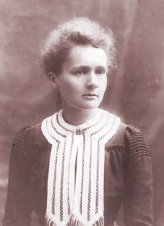Marie Curie

As a Polish student in Paris in 1892, Manya Sklodovska survived on a mere 40 Rubles a month. This translated into 3 francs per day -- which she subsisted on for three years. Not an easy existence considering her expenses included room and board (in a garret), clothes, books and the university fees at the Paris Sorbonne. For weeks at a time she ate nothing but buttered bread and tea. Upon graduation with a masters degree, she intended to return permanently to Poland to teach. However, at the Sorbonne she had caught the attention of physicist Pierre Curie, and after a year of courtship, they married. Thus she became Marie Curie (The name "Manya" is the same as "Maria" in many regions of the slovak countries of Russia, Ukraine, and Poland)
In 1896, Becquerel discovered what Marie Curie later termed as "radioactivity", in samples of uranium. Here was a new phenomenon, perfect for a Ph.D. thesis which Marie still desired to complete. Thus Marie and Pierre began the arduous work of trying to understand these strange rays. They discovered radioactivity was also exhibited by thorium, in addition to uranium. Any element which exhibited radioactivity was called a "radio element" by the Curies. They determined, naturally enough, to investigate which of the known elements also exhibited this phenomenon. When they examined the mineral collection at the local School of Physics, Marie discovered a specimen that was far more radioactive than either uranium or thorium-- and in fact they postulated it was a due to a previously unknown element:
"Certain minerals containing uranium and thorium (pitchblende, chalcolite, uranite) are very active from the point of view of the emission of Becquerel rays. In a preceding communication, one of us showed that their activity was even greater than that of uranium and thorium, and stated the opinion that this effect was due to some other very active substance contained in small quantity in these minerals" Pierre and Marie Curie, Proceeding of the Academy of Science, July 18, 1898.
Further chemical analysis of pitchblende which the Curies imported from Austria at great personal expense, eventually allowed the Curies to announce the discovery of two elements: Polonium (Marie named it after Poland), and the highly radioactive Radium.
Tragedy struck the Curies on April 19, 1906, when Pierre was ran over by a horse drawn wagon in Paris. Maire was then left the task of raising their two daughters, Irene and Eve, alone.
Every morning for the Curie daughters started with a routine that consisted of one hour of work, either intellectual or manual. When they were old enough to attend school, Marie devised the scheme of "Collective Teaching". She contacted her professor friends and colleagues at the Sorbonne who also had children, and together they shared the job of instructing their children. So, the future Nobel laureate Jean Perrin taught them chemistry, and Paul Langevin taught them mathematics. Isabelle Chavannes, the wife of a professor, taught English and German. The sculptor Jean Magrou taught modeling and drawing. Henri Mouton taught them natural science. Marie of course taught physics. The collective school lasted for two years, and according to Eve, it imprinted on them not only a first rate scientific culture, but also a strong taste for work and also a certain independence.
Marie Curie incidentally is one of the few scientists to receive two Nobels (Pauling and Bardeen also share that distinction). As if two Nobels were not enough, Irene also received the Nobel Prize in Chemistry in 1935.